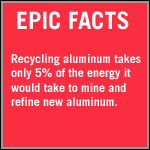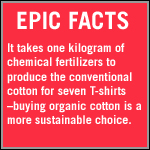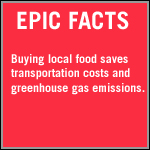Can Green Consumers Make a Difference?
EPIC was a first in Canada, bringing together consumers and suppliers of green products and services spanning a wide array of lifestyle sectors, including food, fashion, home design, personal transportation, travel, investing, recycling and communications, all designed to leave a softer footprint on the earth. Live presentations on sustainable living, eco-fashion shows, and the slideshow from “An Inconvenient Truth”, drew large crowds to the EPIC Main Stage throughout the event.
While EPIC was a celebration of environmentally friendly products and services that could allow shoppers to feel good about their purchases, a more fundamental level of concern motivated the 12,000 visitors participants.
Environmental issues are in the public spotlight as never before seen. Concern over climate change, the degradation of our ecosystems, and rising levels of pollution is at an all time high. In response, many are advocating government policy changes, tighter regulatory controls and more environmentally friendly products and production processes. The number of people becoming more active in promoting change is also on the rise.
But another less obvious, but potentially more powerful level of activism, arises from people that simply exercise the power of choice in terms of the products and services they buy. By using their purchasing power to support sustainability, consumers are bringing about positive environmental and social changes in the marketplace,

Even simple choices such as buying recycled paper products, selecting biodegradable dishwashing soap, or purchasing organic food and clothing, can make a difference. It can extend to purchasing renewable energy for your home, buying a fuel-efficient car, or extensive renovations or upgrades to your home, such as installing heat pumps or solar panels.
Today’s green consumer movement is part of a trend that gained traction during the early 1990s, when the term ‘sustainable development’ was coined. The number of products made from recycled or recyclable content began to rise and ‘organic’ or ‘natural’ became buzzwords in local supermarkets.
Since then there has been an expansion in the products and services that identify themselves as ‘sustainable’ and the choices available for recycled, organic, or environmentally sensitive goods has become wider and easier to make. In the past few years the market for ‘green’ products has leapt forward once again, galvanized by increased public awareness and concern about the environment.
Green consumers exist, and they are growing in numbers, and their purchasing preferences have led to a host of companies developing sustainable product lines. No longer distinguished by a lack of style or a literally ‘green’ appearance, environmentally and socially friendly products now boast the same desirable features as conventional goods, with the added bonus of being ethically attractive.
Cotton Ginny, Patagonia, Mountain Equipment Co-op, and LUSH are just some of the many leading brands that have launched sustainable product lines, and there are many more small companies that are basing their identity on providing environmental and social benefits with their business.
Influencing change in the marketplace
The question remains - can those simple choices, such as buying an organic cotton t-shirt or using energy efficient compact fluorescent light bulbs, have a long term environmental and social impact? Is buying environmentally and socially friendly products really going to save the planet?
Perhaps not single-handedly, but as a component of an overall shift towards a more sustainable society, the power of green spending is considerable. Individual purchasing decisions are strengthened by numbers, and in turn influence the marketplace. As Pierre Millette of Toyota Canada noted in his presentation at the EPIC Main Stage, lasting environmental change will require “Technology plus lifestyle choices.”

Take paper, for instance. Recycled paper uses 55% less water and up to 70% less energy to produce than paper from virgin pulp. Each pack of paper a person buys for use with their home computer carries an environmental and social price, and each individual choice to buy recycled can have a huge cumulative impact. On average, every ton of post-consumer paper waste recycled leaves 17 trees standing and conserves 7,000 gallons of water.
Energy-efficient and water-saving devices for the home are other areas where consumer actions can have a huge impact. For example, compact fluorescent light bulbs use 80% less energy than incandescent bulbs and last up to ten times as long. Front-loading clothes washers use less energy and 40% less water than top-loading machines, while efficient dishwashers use less energy and around half as much water per cycle as others.
Peter Robinson, CEO of Mountain Equipment Co-op (MEC), made the case for organic and sustainable clothing during his presentation. “25% of chemicals produced worldwide are used for textiles,” he said, adding that finishing of textiles generates high quantities of waste water while consuming large amounts of energy.
In response, partly due to customer interest and advocacy, MEC has developed organic products, polyester recycling programs, and is constantly seeking product innovation that both improves design and enhances environmental sustainability.
In today’s highly competitive marketplace, companies listen to their customers. They are constantly surveying, tracking buying habits, and trying to determine what customers want. And if the people speak, not just with their words but with their actions and with their dollars, companies will react.
 If a company’s line of recycled paper products outsells its conventional product line, it will shift towards more recycled fibre. If organic cotton shirts start flying off the shelves, more retailers will seek out these products
If a company’s line of recycled paper products outsells its conventional product line, it will shift towards more recycled fibre. If organic cotton shirts start flying off the shelves, more retailers will seek out these products
Already such products are increasing in availability, but they still represent a small niche of the overall market. Organic foods, for example, represent around 2.5% of the entire food market- a relatively small component, but one that is growing fast.
The true test of the power of the green consumer will come over the next decade, as the movement for sustainable products and services moves more completely into the mainstream marketplace and extends to a wider array of products and services.
If consumers make sustainable choices consistently, the nature of some products may change forever. For example, all computer paper used in North America could be feasibly supplied by recycled paper or alternative fibres such as flax. If people maintain a commitment to buy recycled whenever possible, that could become a reality.
But making such changes will not be easy for everyone. It involves making positive purchasing choices, selecting environmentally and socially friendly options of many every day goods.
In the short term, it may also mean screening out goods that are environmentally negative. If a store doesn’t carry biodegradable soap or recycled paper towels, perhaps the best choice is to delay that purchase until sustainable choices can be found – or better yet, ask the store manager why they don’t provide those options.
In the long term, if enough people make that simple choice consistently, there will be environmentally friendly options in every store, for virtually any type of good. Many green products are already cost-competitive with conventional goods, and those that are more expensive will begin to come down in price as they become more popular.

This will encourage sustainable purchasing even among those that are not committed environmentalists. Some consumers are willing to sacrifice for their beliefs, but for others, green products will only become successful when they match conventional goods for quality and features. As Toyota’s Pierre Millette noted, “Our market research tells us people are willing to buy an environmentally friendly vehicle…but only if all other factors are equal!”
Companies are responding to this, and savvy consumers can save money, protect the environment, and own products that are both stylish and ethically sound.
Many would point out that consumption of material goods and energy is a major cause of the pressures we exert on the natural world, and that we can’t ‘buy our way out of it’. It can be argued that the best response for the environment is to reduce consumption.
While reduced consumption may be desirable, we must face the fact that in our society the lifestyles we enjoy require large inputs of natural resources and raw materials. Given this, the exercise of positive consumer choices in favour of those goods which have the lightest environmental footprint becomes important not only for continued quality of life and improved health, but also for the lasting preservation of the natural world.
Certainly there are other aspects to the environmental challenges facing the planet. Government policies and scientific innovation will be required to make the changes necessary to make our society sustainable. But individual consumers, by exercising choice and making simple commitments to buying environmentally friendly goods, can help drive these changes, reduce their own environmental impact, and more tightly link economic and environmental prosperity.
They literally can help save the planet, one purchase at a time.
You can return to the main Market News page, or press the Back button on your browser.

